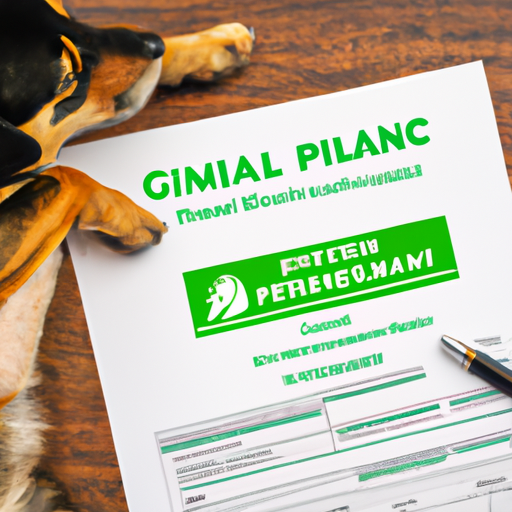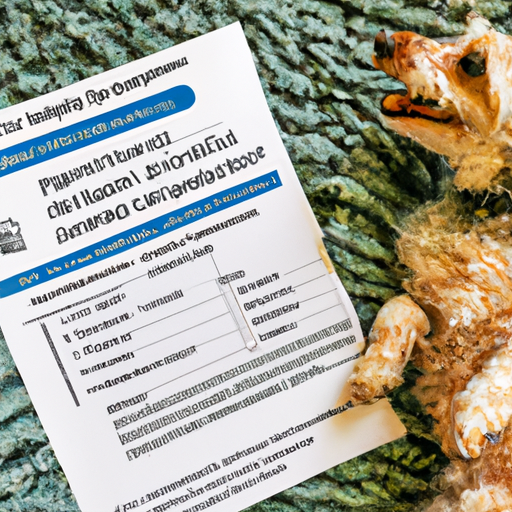Have you ever wondered what the process is for filing a pet insurance claim? It can be confusing to navigate the world of insurance, especially when it comes to your furry friend. Well, fear not! In this article, we will delve into the details of how to file a pet insurance claim, step by step.
First and foremost, you will need to gather all the necessary documentation. This includes your pet’s medical records, any receipts or invoices from the veterinary visits, and any other relevant information that may be required by your insurance provider. Once you have all the necessary paperwork in order, you can proceed to the next step.
The next step is to contact your insurance provider and notify them of the claim. Most insurance companies have a dedicated claims department that you can reach out to. Make sure to provide them with all the necessary information, such as your policy number, your pet’s information, and a detailed description of the treatment or services rendered. They may also ask you to fill out a claim form, so be prepared to provide any additional information requested.
After you have submitted your claim, the insurance company will review the documentation and process the claim accordingly. This may involve verifying the information provided, consulting with the veterinarian if necessary, and assessing the coverage and benefits outlined in your policy. Once the claim has been processed, you will receive a reimbursement or payment for the eligible expenses.
As you can see, filing a pet insurance claim doesn’t have to be a complicated process. By gathering the necessary documentation, contacting your insurance provider, and following their instructions, you can ensure a smooth and hassle-free claims experience. So, if you ever find yourself in need of filing a claim for your furry friend, rest assured that the process is straightforward and accessible.

Understanding Pet Insurance
Pet insurance is a type of insurance policy that helps pet owners cover the cost of veterinary care for their beloved animals. Just like human health insurance, pet insurance provides financial support for a variety of medical services, including accidents, illnesses, and routine check-ups. This article aims to provide pet owners with a comprehensive guide to understanding the process for filing a pet insurance claim, ensuring they can navigate the often complex world of pet insurance and receive the reimbursement they are entitled to.
What is pet insurance?
Pet insurance is designed to help alleviate the financial burden of unexpected veterinary expenses. By paying a monthly premium, pet owners can be reimbursed for a significant portion of their vet bills in case of an accident or illness. Pet insurance policies vary by provider, but most plans cover treatments such as surgery, hospitalization, medication, and some preventative care options. Different policies also offer specific coverage options for various types of pets, including dogs, cats, and exotic animals.

Why is pet insurance important?
Pets are an integral part of our families, and just like our loved ones, they can also experience accidents or illness that require medical attention. However, the cost of veterinary care has been steadily rising over the years, making it challenging for some pet owners to afford necessary treatments. Pet insurance provides peace of mind, knowing that you can provide your pet with the care they need without worrying about the financial implications. It allows pet owners to make decisions based on their pet’s well-being rather than being driven solely by the cost of treatment.
What does pet insurance cover?
Pet insurance policies generally cover a wide range of treatments, but coverage can vary depending on the provider and specific policy. Most plans cover accidents, illnesses, and emergency care, including surgeries, hospitalization, diagnostic tests, and prescription medications. Some policies may also include coverage for preventive care, such as vaccinations, flea and tick prevention, and routine check-ups. It’s crucial to carefully review the policy documents and understand the precise coverage offered by your chosen insurer.

Preparing for a Pet Insurance Claim
Before filing a pet insurance claim, it’s essential to be well-prepared and familiarize yourself with your policy terms and conditions. Here are some steps to help you get ready to file a claim:
Reading and understanding your policy
Take the time to thoroughly read and understand your pet insurance policy. Pay attention to details such as coverage limits, deductibles, reimbursement percentages, and any exclusions or waiting periods. Understanding your policy will help you know what to expect during the claim process and avoid any surprises.
Gathering necessary documents
To file a claim, you will need specific documents, such as your pet’s medical records, itemized invoices, and receipts for veterinary services. It’s important to gather these documents before initiating the claims process to expedite the claim processing time.
Contacting your pet insurance provider
Once you have reviewed your policy and gathered the necessary documents, it’s time to contact your pet insurance provider. Their customer service team can guide you through the claims process and answer any questions you may have. They will provide you with the necessary claim forms and advise you on the next steps.
Step-by-Step Guide to Filing a Pet Insurance Claim
Now that you have prepared for the claims process let’s take a closer look at the step-by-step guide for filing a pet insurance claim:
Contacting your vet
Before filing a claim, it’s essential to inform your veterinary clinic about your intention to file a claim with your pet insurance provider. This helps ensure that they provide you with all the necessary documents, including itemized invoices and medical records, in a timely manner.
Getting a completed claim form
Your pet insurance provider will typically require a completed claim form to process your claim. This form will ask for essential information, including your policy details, your pet’s medical history, and an itemized list of the services received. Make sure to fill out the form accurately and provide all the requested information to avoid any delays.
Attaching supporting documents
To support your claim, you will need to attach any relevant supporting documents, such as itemized invoices, receipts, and medical records. It’s crucial to include all the requested documentation and ensure that they are legible and easy to understand. Clearly highlight the treatments or services for which you are seeking reimbursement.
Submitting the claim
Once you have completed the claim form and attached all the supporting documents, you can submit your claim to your pet insurance provider. You can usually submit claims either by mail or online through the insurer’s website. Follow the instructions provided by your insurer to ensure that your claim is submitted correctly and within the required time frame.
Waiting period for claim processing
After submitting your claim, there is typically a waiting period for its processing. The length of this period can vary depending on the insurer and the complexity of the claim. During this time, the insurance company will review your claim, assess its validity, and determine the reimbursement amount you are eligible for.

Understanding Claim Approval and Reimbursement
Understanding how claims are processed and how reimbursement works is essential to managing your expectations during the pet insurance claim process.
How are claims processed?
Once your claim is submitted, the pet insurance provider will review all the information and supporting documents you have provided. They will assess whether the treatment or service falls within the coverage of your policy and if any exclusions or waiting periods apply. The insurer’s claims department will verify the costs and medical necessity of the treatments and services, comparing them to your policy’s terms and conditions.
Factors that affect claim approval
In order for a claim to be approved, it must meet certain criteria outlined in your policy. Common factors that can affect claim approval include pre-existing conditions, policy waiting periods, and coverage limits. If your claim is denied or partially denied, the insurer should provide a detailed explanation as to why it was rejected.
Understanding reimbursement percentages
Pet insurance policies typically offer reimbursement percentages, which determine the amount you will be reimbursed for covered expenses. The reimbursement percentage is usually based on the overall cost of treatment, excluding any deductibles or co-pays. Most insurers allow you to choose the reimbursement percentage when selecting your policy.
Claim denial and dispute resolution
In some cases, your claim may be denied or only partially approved. If you disagree with the insurer’s decision, you have the right to dispute it. Review your policy documents for information on the dispute resolution process and follow the instructions provided by your insurer. It may involve appealing the decision or seeking assistance from consumer protection agencies.
Timelines and Deadlines
To ensure a smooth claims process, it’s important to be aware of different timelines and deadlines associated with filing a pet insurance claim.
Claim submission deadlines
Most pet insurance policies have specific deadlines for claim submission. It’s crucial to check your policy documents for the exact timeframe within which you must file your claim. Failure to submit the claim within the specified deadline may result in denial or delay of reimbursement.
Timeframe for claim processing
The time it takes for a pet insurance claim to be processed can vary depending on the insurer and the complexity of the claim. While some claims may be processed within a few weeks, others may take longer, especially if additional information or clarification is required. It’s important to be patient and follow up with the insurer if you haven’t received any updates within a reasonable timeframe.
Expected time for reimbursement
Once your claim is approved, the pet insurance provider will typically reimburse you for the covered expenses. Reimbursement timeframes can vary, but most insurers strive to process reimbursements promptly. Some insurers offer direct deposit options to expedite the reimbursement process, while others may issue a check or transfer the funds to your preferred payment method.

Dealing with Claim Rejection
Having a pet insurance claim rejected can be frustrating, but it’s important to understand why it was rejected and what steps you can take to resolve the issue.
Understanding the reason for rejection
If your pet insurance claim is rejected, carefully review the explanation provided by the insurer. The rejection may be due to various factors, such as pre-existing conditions, policy exclusions, or incomplete documentation. Understanding the specific reason for rejection will help you determine the next course of action.
Appealing a rejected claim
If you believe that your claim was wrongly rejected, you have the right to appeal the decision. The appeal process typically involves submitting additional documentation or providing further details to support your claim. Review your policy documents for specific instructions on how to appeal a rejected claim and follow them accordingly.
Seeking assistance from consumer protection agencies
If you have tried to resolve the issue directly with your pet insurance provider and are still unsatisfied with the outcome, you can seek assistance from consumer protection agencies. These agencies can provide guidance, advice, and mediation services to help resolve disputes between policyholders and insurers.
Maximizing Pet Insurance Benefits
To make the most of your pet insurance policy, there are several strategies you can implement to maximize your benefits and ensure your pet receives the best care possible.
Keeping up with policy updates
Pet insurance policies may be subject to updates or changes over time. It’s important to stay informed about any changes that may affect your coverage or reimbursement percentages. Reviewing your policy regularly and contacting your insurer for clarification can help you make informed decisions about your pet’s healthcare.
Using preferred providers
Some pet insurance companies have networks of preferred providers, including veterinarians and specialists. These preferred providers often have pre-negotiated rates with the insurer, which can result in cost savings for policyholders. To take advantage of these discounts, consider using preferred providers whenever possible.
Taking advantage of discounts
Pet insurance companies may offer additional discounts or incentives for policyholders. These discounts can include multi-pet discounts, military discounts, or discounts for paying premiums annually instead of monthly. Exploring these options and taking advantage of any available discounts can help reduce your out-of-pocket expenses.
Regular check-ups and preventative care
Preventative care plays a crucial role in maintaining your pet’s health and well-being. Most pet insurance policies cover routine check-ups, vaccinations, and preventive medications. By staying up to date with these preventive measures, you can catch any potential health issues early on and minimize the need for more expensive treatments down the line.
Common Pet Insurance Claim Mistakes to Avoid
Filing a pet insurance claim can be a complex process, and there are some common mistakes that pet owners should be aware of to avoid any unnecessary delays or denials.
Incomplete claim forms
One of the most common mistakes is submitting incomplete claim forms. Ensure that you fill out all the required fields and provide accurate and detailed information. Any missing or incorrect information can cause delays in the claim processing time or lead to a denial.
Missing supporting documents
Accurate and complete supporting documents are essential for a successful claim. Make sure to include all the necessary invoices, receipts, and medical records. Missing or incomplete documentation can result in the rejection or partial approval of your claim.
Not following claim submission instructions
Each pet insurance provider may have specific requirements and instructions for submitting claims. It’s crucial to read and follow these instructions carefully. Failure to do so may result in the rejection of your claim or unnecessary delays in the processing time.
Tips for a Smooth Pet Insurance Claim Experience
To ensure a smooth and hassle-free pet insurance claim experience, consider the following tips:
Being proactive and organized
It’s important to be proactive and organized throughout the claims process. Start by reviewing your policy, understanding the terms and conditions, and gathering the necessary documents in advance. This will help streamline the process and reduce the chance of missing any crucial information.
Communicating effectively with your vet and insurer
Open and effective communication plays a vital role in the claims process. Inform your veterinary clinic about your pet insurance coverage and intent to file a claim. They can provide all the necessary medical documentation promptly. Additionally, stay in touch with your pet insurance provider and ask any questions you may have to ensure a clear understanding of the process.
Maintaining good records
Keeping thorough records of your pet’s medical history, including invoices, receipts, and medical reports, is essential for filing a successful claim. Maintain a dedicated file or folder to store all the relevant information. This will allow you to easily access any necessary documents when it’s time to file a claim.
Conclusion
Understanding the process for filing a pet insurance claim is crucial for pet owners seeking financial support for their beloved animals’ healthcare needs. By familiarizing themselves with the step-by-step guide, being aware of timelines and deadlines, and avoiding common mistakes, pet owners can navigate the pet insurance claims process with confidence and ensure they receive the reimbursement they are entitled to. The peace of mind that pet insurance provides, knowing that you can provide quality care for your furry friends without the fear of financial strain, is priceless. So, take the time to research and choose the right pet insurance policy for your pet’s needs and protect their well-being for years to come.

